Best Cordless Mid-Torque Impact Wrench Head-2-Head
Cordless Mid-Torque Impact Wrench Head-2-Head
In standard fashion, the Tool Box Buzz crew got together to plan out our Head-2-Head tests based on new tool releases and your feedback. And Cordless Mid-Torque Impact Wrenches were near the top of our list. The impact wrench is an incredibly versatile tool that provides unparalleled torque and power for working with large fasteners and bolts. We use them on the jobsite early and often! This Head-2-Head in particular provides an in-depth look at the power, performance, ergonomics, features, and more for the current range of leading manufacturer cordless mid-torque impact wrenches.
An impact wrench is indispensable to many other skilled trades workers, amateurs, and tinkerers, and is a mainstay of the mechanic’s toolbox. Furthermore, cordless technology adds simplicity and portability to a tool that was previously bound by an air-hose leash.
Our Professional contractor-based ToolBoxBuzz crew decided to evaluate the current cordless mid-torque impact wrenches to determine just how capable they really are. We put a total of nine different makes and models through a series of tough and baseline tests. This wide testing field covers everything from well-known professional brands to some surprising homeowner and value brands.
In order to get real-world and professional user feedback, we took our tools on-site; to the Dalling Construction company. Dalling specializes in large site work projects as well as utility construction and paving jobs. The Dalling family was kind enough to allow us to use their yard as well as test our cordless mid-torque impact wrenches on some of their industrial equipment. We also recruited some heavy equipment service mechanics to assist with evaluating the tools. They were pretty excited to join our crew for the Day!
Defining Mid-Torque
The range of cordless impact wrenches available right now is huge. These tools ultimately fall into one of three classes – low, medium (or mid), and high torque. A mid-torque offering is capable of handling the majority of common fasteners found on job sites, shops, and industrial settings.
When deciding on our sample criteria for this Head-2-Head, the crew realized that we needed to limit the tools tested to those within a defined range. We chose fastening torque as our limiting factor and set the acceptable range from 300-550 Ft/Lbf. This range best represented what we consider “mid-torque” while being compact and portable enough for a variety of applications. This torque range will also easily handle most common fastener applications while still being able to punch up to the occasional heavy application.
The Head-2-Head Lineup
Craftsman V20* 1/2″ 20V
- Model: CMCF900B
- Fastening Torque: 350 Ft/Lbf
- Busting Torque: Unpublished
- RPM: 1700
- IPM: 2500
- Bare Tool Weight: 4.66 Lbs.
- Battery Tested: V20 4.0 Ah
- Anvil Type: Friction Ring
- Motor Type: Brushed
DEWALT 20V MAX* XR 1/2″ Mid Range
- Model: DCF896B
- Fastening Torque: 330 Ft/Lbf
- Busting Torque: Unpublished
- RPM: 2000
- IPM: 3100
- Bare Tool Weight: 3.48 Lbs.
- Battery Tested: 20V MAX 5.0 Ah
- Anvil Type: Friction Ring or Detent Pin
- Motor Type: Brushless
- Warranty: 3 Year Limited
DEWALT Atomic 20V Max* 1/2″ 
- Model: DCF921B
- Fastening Torque: 300 Ft/Lbf
- Busting Torque: 450 Ft/Lbf
- RPM: 2500
- IPM: 3550
- Bare Tool Weight: 2.4 Lbs.
- Battery Tested: 20V MAX XR 4.0 Ah
- Anvil Type: Friction Ring or Detent Pin
- Motor Type: Brushless
- Warranty: 3 Year Limited
Makita 18V LXT 1/2″ Mid-Torque
- Model: XWT18XVZ
- Fastening Torque: 520 Ft/Lbf
- Busting Torque: 740 Ft/Lbf
- RPM: 2200
- IPM: 2700
- Bare Tool Weight: 5.31 Lbs.
- Battery Tested: 18V LXT 5.0 Ah
- Anvil Type: Friction Ring or Detent Pin
- Motor Type: Brushless
- Warranty: 3 Year Limited
Metabo SSW 18 LTX 600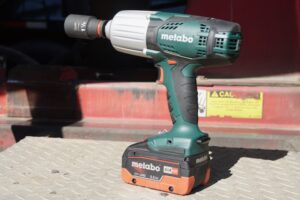
- Model: US602198550
- Fastening Torque: 450 Ft/Lbf
- Busting Torque: 665 Ft/Lbf
- RPM: 1600
- IPM: 2200
- Bare Tool Weight: 5.5 Lbs.
- Battery Tested: CAS 18V LiHD 5.5 Ah
- Anvil Type: Friction Ring
- Motor Type: Brushed
- Warranty: 3 Year Limited
Milwaukee M18 FUEL 1/2″ Mid Torque
- Model: 2962-20
- Fastening Torque: 550 Ft/Lbf
- Busting Torque: 650 Ft/Lbf
- RPM: 2575
- IPM: 3100
- Bare Tool Weight: 3.5 Lbs.
- Battery Tested: M18 REDLITHIUM XC 5.0 Ah
- Anvil Type: Friction Ring or Detent Pin
- Motor Type: Brushless
- Warranty: 5 Years
Porter-Cable 20V MAX* 1/2″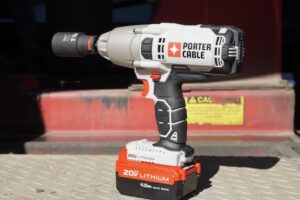
- Model: PCC740B
- Fastening Torque: 330 Ft/Lbf
- Busting Torque: Unpublished
- RPM: 1700
- IPM: 2500
- Bare Tool Weight: 4.6 Lbs.
- Battery Tested: 20V MAX* 4.0 Ah
- Anvil Type: Friction Ring
- Motor Type: Brushed
- Warranty: 3 Year Limited
Ridgid 18V OCTANE 1/2″
- Model: R86011B
- Fastening Torque: 485 Ft/Lbf
- Busting Torque: 620 Ft/Lbf
- RPM: 2600
- IPM: 3500
- Bare Tool Weight: 3.75 Lbs.
- Battery Tested: 18V MAX Output 4.0 Ah
- Anvil Type: Friction Ring
- Motor Type: Brushless
- Warranty: 3 Year Limited
Ryobi ONE+ HP 1/2″
- Model: P262
- Fastening Torque: 450 Ft/Lbf
- Busting Torque: 600 Ft/Lbf
- RPM: 2800
- IPM: 3200
- Bare Tool Weight: 3.75 Lbs.
- Battery Tested: 18V One+ 4.0 Ah
- Anvil Type: Friction Ring
- Motor Type: Brushless
- Warranty: 3 Years
Selecting the Proper Accessories

We realized that adequate automotive-grade impact-rated sockets were essential for extracting the absolute peak performance from this equipment. When it comes to getting professional-grade results on a project, choosing the right blade or drill bit is crucial, and the same goes for sockets. Impact wrenches apply a tremendous amount of force and punishment to the sockets to which they’re attached. To fully utilize the tool’s power, the torsional force, as well as the impact of the anvil, must be adequately delivered to the bolt or fastener.
A non-impact rated standard socket will round off, deform, or possibly shatter and explode when exposed to this amount of force. Impact-rated sockets are forged from high-grade steel, with thicker walls, and improved geometry. This protects the fastener and the tool from being damaged while also ensuring the safety of the user.
The crew selected the Milwaukee SHOCKWAVE Impact Duty 1/2″ 6-Point sockets to be our testing sockets for all of the tools. These sockets are optimized for performance in Heavy-Duty applications. Each tool was outfitted with a matching Milwaukee socket during testing to ensure consistency in performance. Overall these sockets are of excellent quality with large easy to read ink-filled markings. The dual-hole design also made it easier to switch out sockets on our tools with detent pin anvils.
Cordless Mid-Torque Impact Wrench Scoring Criteria
- Power – Measured breaking torque capability under high demand.
- Speed – Timed breaking torque performance application.
- Torture Test – High demand performance fastening torque application.
- Ergonomics
- Features
- Decibel Output
- Price
Breaking Torque
The bread and butter of impact wrenches is their ability to break a stuck or corroded fastener loose. This keeps an individual’s knuckles from getting busted using a wrench or having to put lengths of pipe on a breaker bar for extra leverage. The convenience and portability of cordless make this an even easier task to accomplish. In order to put this power to the test, we created some special test jigs.

To give us a solid, repeatable, work surface, we made a portable jig that could be secured in a vise on-site. This jig is made from a large slab of steel with cutouts for bolts to pass through as well as a chamfer on the backside to lock the nuts in place. We paired this testing jig with a set of heavy-duty Grade 8 steel bolts, nuts, and washers. The bolts are 1 1/4″ in diameter by 3 1/2″ long with a 1 7/8″ hex head. A bolt this large is capable of withstanding 1,875 Ft/Lbf of force. We chose such a large bolt in order to withstand the repeated application of torque during testing, while still fitting our test rig.

In order to torque these bolts to the desired spec, we used a B-RAD Select BL cordless torque system. This digitally controlled tool is capable of applying the desired amount of tightening torque to a bolt effortlessly. The digital torque gauge allows the user to dial in the torque spec in ten-pound increments. By using a 1″ drive impact socket, the RAD tool then applies the torque with the assistance of a steel counterbalance lever. The RAD then automatically stops once the torque spec is achieved. It was a really cool experience using this tool!

During the test, a bolt was assigned to each tool and placed in the jig. The bolt was then torqued to the published breaking torque spec for each tool. Unfortunately, Craftsman, DEWALT, and Porter-Cable do not publish this value so it took some trial and error. Once the bolt was torqued, our impact wrenches were fitted with a 1 7/8″ impact socket and switched to their highest setting. We then applied breaking torque to the bolts with the impact wrench for ten seconds to see if the tool could break it loose. If it was unsuccessful, the bolt was loosened and the torque value lowered ten pounds, and reapplied with the RAD.
We chose to limit each run to ten seconds after discussing the test with several heavy service mechanics. They all agreed that if the tool couldn’t perform the task in ten seconds, then they would stop and switch to a larger or traditional pneumatic tool.
| Manufacturer | Published Torque (Ft/Lbf) | Tested Breakaway (Ft/Lbf) | Rank |
| Makita | 740 | 700 | 1 |
| Metabo | 665 | 660 | 2 |
| Milwaukee | 650 | 610 | 3 |
| Ryobi | 600 | 510 | 4 |
| Ridgid | 620 | 500 | 5 |
| Porter Cable | 330 | 330 | 6 |
| Craftsman | UNKNOWN | 320 | 7 |
| DEWALT | UNKNOWN | 310 | 8 |
| DEWALT Atomic | 450 | 310 | 8 |
Our top-performing tool in this category is Makita. While the Makita has a published breaking-force torque of 740 Ft/Lbf, we were able to successfully break loose the bolt at 700 Ft/Lbf. This variation in the numbers is consistent with the extra-large hardware and accompanying impact socket. Despite that, the Makita powered through our test! Not only was the Makita our strongest performer, but it also broke the 700 Ft/Lbf bolt loose in well under ten seconds. This was remarkable to our entire test crew.
Metabo took second place breaking loose 660 Ft/Lbf which was within five pounds of its published spec. The Metabo is definitely large and in charge. While larger and heavier than every other tool tested, it hits with authority. After performing the test, the Metabo became our admin tool to reset the jig every time due to its smooth and powerful performance.
Milwaukee took third place breaking loose 610 Ft/Lbf, which was forty pounds less than its published spec. The Milwaukee was a consistent performer and a crew favorite throughout the testing process.
Craftsman, DEWALT, DEWALT Atomic, and Porter-Cable all finished towards the bottom of our test pool. Ridgid and Ryobi threw up some impressive numbers, but they were far less than the published spec. Additionally, the Ridgid overheated during the testing process severely. It shut down completely and was set aside for almost an hour before it was able to function again and finish the test.
The Ryobi tool died unexpectedly. While performing the test, the tool shut off after impacting for approximately six seconds. All of the lights flashed and the tool wouldn’t work again. We switched batteries, allowed the tool to cool, and still experienced the same issue. The tool then randomly started working again later on. Ryobi replaced this unit for us, but we experienced the same malfunction a second time. The tool was still able to complete the test and break loose 510 Ft/Lbf, but unfortunately, the Ryobi does not appear to be able to withstand demanding heavy use with a socket this large.

Performance Breaking Torque
When you are in a construction yard with a lot of big iron laying around, lug nuts are in great supply. That’s why we chose a timed removal of heavy truck lug nuts as our test for breaking torque performance. With heavy equipment, the forces placed on bolts, particularly lug nuts, are so extreme that they will often seize in place or be over-torqued in the field using a large air tool. Fortunately for us, a large MACK tractor cab was available with lug nuts capable of withstanding 500-600 Ft/Lbf of torque.
The front wheel of the truck had a total of ten lugs. We choose to do a timed removal of eight in order to keep the wheel in place and act as a makeshift test rig. Each lug was removed, oiled to prevent seizing, and then reapplied with the RAD Tool to exactly 500 Ft/Lbf. This process was repeated eight times to test each tool. Unfortunately, the DEWALT Atomic was not available in time to perform this test. Therefore it will not be included in the scoring. The Atomic is also not marketed as a true mid-torque tool and this task is better suited for the larger DEWALT DCF896B, which was tested.
| Manufacturer | Time | Rank |
| Ryobi | 0.22.44 | 1 |
| Ridgid | 0.23.60 | 2 |
| Milwaukee | 0.25.58 | 3 |
| Makita | 0.26.10 | 4 |
| Porter Cable | 0.49.36 | 5 |
| Metabo | 1.00.32 | 6 |
| Craftsman | 1:14.17 | 7 |
| DEWALT | 1.31.09 | 8 |
| DEWALT Atomic | N/A | N/A |
Ryobi completely smoked this test with a time of 22.44 seconds. After completing the run, the whole crew did a double-take and then started laughing. Ryobi has made great strides to produce better and more powerful tools and this performance was a great example of that new mindset.

Ridgid came in a close second at 23.6 seconds. Again, these two “value” brands are continuing to push the envelope of performance. Milwaukee took third place at 25.5 seconds and Makita in fourth at 26.1. These were the top performers amongst our traditional Pro brands.
DEWALT was a big surprise to us as our slowest tool finishing the test in over a minute and a half. One of our test crew members, Trevor, is a road mechanic servicing a fleet of trucks and earthwork equipment. Trevor shared with us that removing truck lug nuts is a job that he always defaults to air tools for the sake of time and productivity. However, after getting hands-on experience with our cordless mid-torque impact wrenches he was extremely impressed with their ability to break loose all eight bolts and to do it quickly.

Performance Fastening Torque
While impact wrenches are most commonly associated with the mechanical trades, they are invaluable at times in the carpentry world as well. With the current popularity of timber frame construction as well as the increasing presence of laminate-type materials, large lag-type fasteners are a job site standard. A cordless mid-torque impact wrench is the most efficient tool for these larger fasteners due to its ability to apply massive amounts of torque compared to a quarter-inch impact driver.
We decided to truly stress our tools by performing a timed lag bolt drive into a wooden beam. The bolts selected were 1/2″ diameter x 8″ long hex head galvanized lag screws. Driving one of these lags is a good representation of the power of each tool. However, we decided to drive five with each tool. It gets better. The beam that we drove the lags into was constructed using five layers of 2X10X10 Doug Fir framing lumber with a layer of 1.75″ LVL sandwiched in the middle. We pre-drilled through the first two layers of material and partially into the LVL in order to set the lags, however, we left all the other layers undrilled to test the tools even further.
This was an extremely demanding test. In fact, a job such as this is likely outside the scope of what a mid-torque tool is designed to perform. But with all the technology advances present in the majority of our tested tools, we as a crew really wanted to bring that performance to the ragged edge of failure and see how they held up. We were pleasantly surprised to find that all nine tools successfully completed the test. All five lags were driven until the surface of the wood began to deform. Upon completion, a temperature reading was taken of the tool body housing, the battery, the exterior of the socket, as well as the surface of the anvil. The battery was also checked to see power consumed during the test.
| Manufacturer | Time | Tool Body Temp (°F) | Battery Temp (°F) | Socket Temp (°F) | Anvil Temp (°F) | Battery Used | Rank |
| Ryobi | 2:48.9 | 123.1 | 104 | 185 | 162.7 | 50% | 1 |
| Ridgid | 3:12.8 | 135.9 | 110.3 | 195.8 | 149.9 | 50% | 2 |
| Milwaukee | 3:20.8 | 122.7 | 91.6 | 167.5 | 181.2 | 50% | 3 |
| Metabo | 3:43.7 | 87 | 86 | 176.7 | 144 | 25% | 4 |
| DEWALT Atomic | 4:09.0 | 158.7 | 97.2 | 201 | 112.3 | 25%% | 5 |
| Porter Cable | 4:42.0 | 110.3 | 96.6 | 135.9 | 191.4 | UNK | 6 |
| Makita | 4:47.4 | 135 | 111.4 | 164 | 129.7 | 25% | 7 |
| DEWALT | 5:26.0 | 104.5 | 97 | 193 | 198 | 75% | 8 |
| Craftsman | 5:27.0 | 133.3 | 86 | 191 | 140 | 75% | 9 |
In first place was the Ryobi! The Ryobi completely dominated the test, finishing a full 25 seconds ahead of our second-place finisher. Upon completion of the test, the operator summed it up perfectly, “This thing is an Ox!”.
Ridgid took second place beating out Milwaukee (3rd Place) by just eight seconds. In 4th place, the Metabo is heavy but has very little felt vibration. Porter-Cable also surprised our crew with its performance in this test. It was described by the operator as being balanced in the hand and easy to control.
Makita came in 6th place, which was a bit of a surprise. The Makita seemed to slow down and self-adjust more than any tool, even while in the highest power setting. The Makita’s computer system optimizes battery efficiency and protects the motor and battery packs. This became a bit of a hindrance during this test because it caused the Makita to lose time. DEWALT finished 7th overall with Craftsman in 8th place.
Overall we found interesting data trends during this test. Most of the tools used half of a battery charge to complete all five lags. The Metabo, with its brushed motor, consumed 75%.
The temperature range was also very spread out. Five of the test tools had a socket surface temperature of almost 200° F. While the battery temperatures measured were only surface temperature readings, three tools were over 100° F, including our 1st and 2nd place finishers. In real-world conditions, a rest period for the tool after performing a task like this would be strongly advised to preserve your battery cells and internal electronics.
Ergonomics
How a tool interfaces with the user and the level of comfort that it provides is a huge consideration for most users. The repetitive nature of the daily tasks associated with a lifetime in the construction industry can lead to long-term fatigue and even injury with an uncomfortable or unbalanced tool. However, ergonomics are often very subjective.
In order to rank our tools, we chose a total of twelve categories. The tools were given a point value for each category, from one to five. One being the best and five being the worst. If a tool completely lacked that feature, it was given a six for the category. These points were then added up to give us our rank structure with the lowest score winning.
| Manufacturer | Grip Ergos | Ease of Controls | Switches | Felt Vibe | Quality Materials | Material Fitment | Weight W/ Batt |
| Makita | 1 | 2 | 1 | 2 | 1 | 1 | 3 |
| DEWALT Atomic | 1 | 1 | 1 | 2 | 2 | 2 | 1 |
| DEWALT | 2 | 1 | 2 | 4 | 3 | 2 | 1 |
| Ryobi | 1 | 2 | 3 | 2 | 2 | 2 | 1 |
| Milwaukee | 2 | 2 | 3 | 3 | 2 | 2 | 5 |
| Ridgid | 2 | 2 | 3 | 4 | 3 | 3 | 2 |
| Metabo | 2 | 2 | 3 | 2 | 2 | 2 | 5 |
| Craftsman | 2 | 3 | 4 | 4 | 5 | 5 | 3 |
| Porter Cable | 3 | 3 | 4 | 4 | 4 | 4 | 3 |
| Manufacturer | Balance | Overall Size | Battery Change | Battery Slop | Battery Display | Total Points | Rank |
| Makita | 2 | 3 | 2 | 1 | 1 | 20 | 1 |
| DEWALT Atomic | 2 | 1 | 2 | 3 | 4 | 22 | 2 |
| DEWALT | 1 | 2 | 2 | 3 | 2 | 25 | 3 |
| Ryobi | 1 | 2 | 3 | 4 | 3 | 26 | 4 |
| Milwaukee | 5 | 1 | 5 | 1 | 1 | 32 | 5 |
| Ridgid | 2 | 2 | 4 | 4 | 3 | 34 | 6 |
| Metabo | 5 | 5 | 5 | 1 | 1 | 35 | 7 |
| Craftsman | 3 | 5 | 2 | 4 | 4 | 44 | 8 |
| Porter Cable | 2 | 5 | 2 | 4 | 6 | 44 | 8 |
Makita took first place in this category. The Makita’s contoured grip, high-quality switches, and controls, as well as minimal felt vibration made it a crew favorite. While not the lightest tool we tested, the Makita packs a ton of power and performance into a sleek package.

The DEWALT Atomic with a 1 7/8″ impact socket attached. AKA the Noisy Cricket.
The DEWALT Atomic came in second. This mighty little powerhouse is extremely comfortable and compact in the hand. Unfortunately, the small size and light-weight translate into more felt vibration for the user during demanding tasks.
The full-size DEWALT came in third with an extremely comfortable design and very minimal felt vibration. Ryobi finishes fourth with a grip that is well suited to larger hands. Ridgid came in fifth with generous overmolding and texturing.

A trend we noticed amongst all of the tools was a preference from our crew for the compact tools with brushless motors. Both DEWALT models, Makita, Milwaukee, Ridgid, and Ryobi all feature compact tool head designs that are balanced and proportionate with the overall footprint with a battery inserted. The larger and more bulky tools were more unpleasant to use because they felt unbalanced and cumbersome.
Cordless Mid-Torque Impact Wrench Features
Our sample body of tools offered a broad range of feature options. From barebones bolt busters to tools with so many different modes you need an engineering degree to understand them. Consequently, the entire crew worked together to sort out what features are great and desirable and which were poorly executed or unnecessary. The features we examined were modes, special settings, ability to dial in torque, and quality of the LED work light.

The Makita featured the most special settings of any of the tools. With three forward and three reverse auto stop modes, the XWT18XVZ is capable of dialing in the torque value for any fastener. Additionally, there are four different selectable IPM and RPM modes as well as a full-speed mode. All of these modes are easily selected by the push-button controls, but they were a little confusing at first to the test crew. However, we quickly warmed up to them and appreciated the level of adjustability available. You can read more about the Makita features in one of our recent ToolBoxBuzz reviews.
Makita also included a vibration-resistant coupling at the base of the tool. This protects the battery pack from absorbing excessive felt vibration, which saves the contacts and prolongs the life of the battery. For all of these reasons, the Makita was our overall winner in the features category.
| Manufacturer | Modes | Special Settings | Ability to Dial In Torque | Quality of LED Beam | Total Points | Rank |
| Makita | 1 | 1 | 1 | 2 | 5 | 1 |
| DEWALT Atomic | 2 | 2 | 1 | 1 | 6 | 2 |
| Milwaukee | 2 | 2 | 2 | 1 | 7 | 3 |
| Ridgid | 2 | 2 | 2 | 1 | 7 | 3 |
| Ryobi | 2 | 2 | 2 | 1 | 7 | 3 |
| DEWALT | 3 | 2 | 3 | 3 | 11 | 6 |
| Metabo | 6 | 6 | 3 | 3 | 18 | 7 |
| Craftsman | 6 | 6 | 4 | 4 | 20 | 8 |
| Porter Cable | 6 | 6 | 4 | 4 | 20 | 8 |
Second place went to the DEWALT Atomic. This mini powerhouse features an excellent triple LED light system in the face of the tool. The controls are also easy to use with large push-button controls for the two-speed settings as well as the dedicated lag screw mode, LED light control, and auto spin-out mode which slows the tool once a faster has come loose to prevent it from flying across the room. The push button and easy-to-identify pictures were all appreciated by us knuckle-draggers on the crew.

In third place, we have a three-way tie between Milwaukee, Ridgid, and Ryobi. All three of these tools feature a triple LED light system on the face of the tool, as well as three forward and three reverse speeds and an additional Auto mode.
The Milwaukee and Ryobi use digital push button switches at the base of the tool while the Rigid uses a manual switch located on the top. The auto mode stops the tool during fastening as soon as it begins impacting in order to prevent over-tightening. In reverse, they will slow to prevent throwing a loose fastener. The Auto mode of these tools was extremely helpful to our test crew when we snug up fasteners in our testing jigs before performing the tests.
The fourth place was DEWALT with the best non-halo style work light located at the base of the tool. The DEWALT also features an easy-to-reach, positive, manual mode selector switch. Metabo finished fifth with an excellent variable speed trigger, but lacked any special modes and has a pretty terrible work light. Craftsman and Porter-Cable tied for the sixth place spot due to lacking any special modes or features and very average work lights and variable-speed triggers.
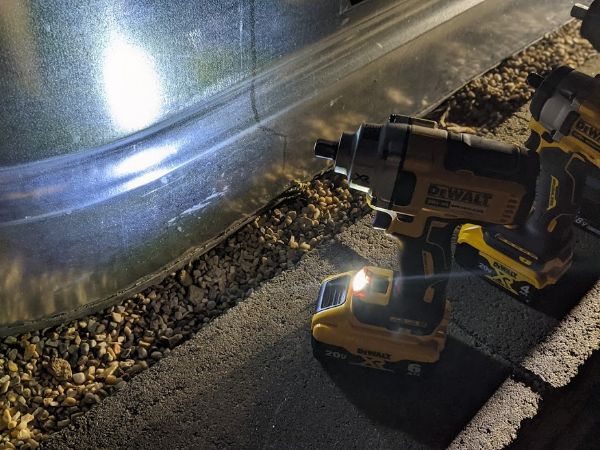
Overall, our crew found an overwhelming preference for the tools with triple “halo” style LED work light systems located on the face of the tool. The DEWALT Atomic, Milwaukee, Ridgid, and Ryobi all featured this style of light. We found it superior to any other style due to the fact that it illuminates more of the work area clear and directs the beam at the socket or fastener. The Milwaukee was the best of all of these tools, with the brightest and widest spill of any of the tools. Some of the tools, like the Ridgid, feature a dedicated light switch to activate the light without pulling the trigger. This felt unnecessary to our crew and we chose to omit it from consideration when determining our rankings.

Decibel Rating
The sound of a pneumatic impact wrench is unmistakable. Our cordless impact wrenches sounded less like their pneumatic counterparts and more like impact drivers on steroids. During the lag bolt drive, we measured the at-ear decibel levels for each tool under load. The under-load level was most important to us to truly gauge the potential for hearing damage in the field.
| Manufacturer | Recorded Db | Rank |
| Craftsman | 73.4 | 1 |
| DEWALT | 74.6 | 2 |
| DEWALT Atomic | 79.2 | 8 |
| Makita | 78.1 | 5 |
| Metabo | 76.5 | 4 |
| Milwaukee | 78.1 | 5 |
| Porter Cable | 75.8 | 3 |
| Ridgid | 78.9 | 7 |
| Ryobi | 78.3 | 6 |
Our decibels readings showed almost the completely opposite results of our speed and performance tests. The quietest tool was the Craftsman (73.4Db) followed by DEWALT in second (74.6) and Porter-Cable in third (75.8).

Our faster and more powerful tools produced more noise during use, which directly correlates to their high RPM, IPM, and torque specifications. Ryobi, Ridgid, and DWALT Atomic were our loudest tools. With Makita and Milwaukee in the middle of the pack.
While all nine of our tools were under the OSHA mandated hearing protection level of 85 decibels, this test was conducted outside in an open space. We strongly recommend hearing protection while using any of these tools. Especially when working indoors or in confined spaces.
Cordless Mid-Torque Impact Wrench Pricing
Pricing is often one of our most difficult categories to consider. With the multitude of online retailers currently, a massive scatter-plot chart has to be made for each tool to figure out pricing. Kit vs. bare tool pricing also rears its ugly head when sifting through this data as well. Because of all this, we choose to rank our tools based on bare tool pricing, however, pricing is not considered when determining our overall winner.
| Manufacturer | Price | Vendor | Rank |
| Porter Cable | $120.00 | Lowe's | 1 |
| Craftsman | $129.00 | Lowe's | 2 |
| Ryobi | $159.00 | Home Depot | 3 |
| Ridgid | $179.00 | Home Depot | 4 |
| DEWALT | $199.00 | ACME Tools | 5 |
| DEWALT Atomic | $199.00 | ACME Tools | 5 |
| Milwaukee | $219.00 | ACME Tools | 6 |
| Metabo | $249.00 | ACME Tools | 7 |
| Makita | $289.00 | ACME Tools | 8 |
As of the time of publishing this article, Porter-Cable is our lowest price tool at $120.00 as a bare tool. Craftsman is the next cheapest and Ryobi comes in third. Metabo is our second most expensive tool at $249.00 and Makita breaks the bank as our most expensive tool at $289.00. The high price tag of the Makita is no surprise given the multitude of technology and features it comes with.
Below are Buy Now links where you purchase many of the tools featured in this Head-2-Head from some of our favorite retailers.
Buy Now From Our Sponsored Retailers
Overall Value
The overall value category is one of our crew favorites. This category is where we directly compare out-of-pocket expense to raw performance. Users currently invested in a cordless battery platform may not value this award, but it caters to the first-time buyer.

Our pick for the best overall value is the Ryobi. The Ryobi took first place in both our performance fastening test (lag bolts) and performance breaking torque (lug nuts) tests, by a considerable margin. Additionally, it tied for third place in features and took fourth place in ergonomics. All of this while being our third most affordable tool. The Ryobi built up an impressive pedigree during our testing and greatly impressed the crew overall. The Ryobi One+ HP impact wrench is a great example of the future of Ryobi tools. While we did experience some issues with our testing samples, the performance was undeniable.
Best Cordless Mid-Torque Impact Wrench
At the end of the day, our goal is to determine which cordless mid-torque impact wrench is best overall. This is a decision not based on conjecture but on real-world quantified data and testing. After completing all of our testing and analyzing the results, we found that we have a tie for first place between Makita and Ryobi.
| Manufacturer | Breaking Torque | Perf Fastening | Perf Breaking | Ergo | Features | db | Total Points | Rank |
| Ryobi | 4 | 1 | 1 | 4 | 3 | 6 | 19 | 1 |
| Makita | 1 | 7 | 4 | 1 | 1 | 5 | 19 | 1 |
| Milwaukee | 3 | 3 | 3 | 5 | 3 | 5 | 22 | 3 |
| Ridgid | 5 | 2 | 2 | 6 | 3 | 7 | 25 | 4 |
| Metabo | 2 | 4 | 6 | 7 | 7 | 4 | 30 | 5 |
| DEWALT Atomic | 8 | 5 | 9 | 2 | 2 | 8 | 34 | 6 |
| DEWALT | 8 | 8 | 8 | 3 | 6 | 2 | 35 | 7 |
| Porter Cable | 6 | 6 | 5 | 8 | 8 | 3 | 36 | 8 |
| Craftsman | 7 | 9 | 7 | 8 | 8 | 1 | 40 | 9 |

Makita was first in breaking torque as well as ergonomics and features. Overall the crew felt that the Makita is a hi-tech, sleek, and outstandingly well-built tool. It was powerful during all of our testing, although the built-in safety and preservation features hurt it slightly during the lug nuts and lag bolts tests. We all expected a show stopper with the Makita, and it delivered.

The Ryobi really threw us for a loop. The power and speed of this tool dropped a lot of jaws on testing day. Landslide victories go to Ryobi in both of our performance tests, while maintaining a top-five finish in all but one category, and being named best value! We were expecting a lot out of this tool, but it blew all of our expectations out of the water. The Ryobi earned a first-place rank in our Head-2-Head based on performance, but we did experience some durability issues. The One+ HP impact wrench is incredibly powerful, but the thermal overload protection built into it stopped it dead on two occasions during our use. When considering this, the Ryobi may not be best suited for daily professional-grade use, such as with a service mechanic.
Tie Breaker

With a tie in the first place, we omit second place to rank all nine participating tools. Therefore, Milwaukee drops into the third-place slot. The Milwaukee mid-torque impact wrench was a consistent performer. Finishing top-five in every single category.
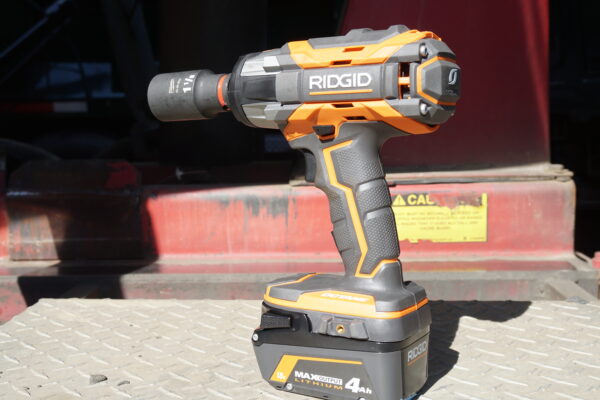
Ridgid finished in fourth place. ToolBoxBuzz has always referred to Ridgid as one of the absolute best values in tools. The Ridgid Octane’s performance lived up to its reputation. Metabo finished fifth and was a hard worker. While it lacks some of the bells and whistles that other brands provide, it simply works.

The new DEWALT Atomic was a late entry to the competition and had impressive features, which brought it to sixth place. The original legacy DEWALT mid-torque was also extremely comfortable to use and finished seventh. Rounding out the bottom end of our lineup was Porter-Cable in eighth and Craftsman in ninth.

With this Head-2-Head, our goal was to develop testing protocols that blended specifically calibrated vacuum scenarios, as well as real-world applications. During the process, we made all of our data as transparent as possible. This way readers, consumers, and professionals can select a tool that best meets their needs. While we crowned what we consider to be the best cordless mid-torque impact wrench, we encourage you to use our findings to help make the decision that best meets your individual needs.
About the author
8 Comments
Leave a comment
Disclosure
Product reviews on this site contain our opinion of a product or service. We will always strive for objectivity and transparency in our reviews. Our goal is to provide readers with honest, objective information based on our own experiences. We never have and never will accept payment in exchange for a positive review. Many of the products that we review are provided to us for free by a manufacturer or retailer. In some cases, we also have advertising or affiliate relationships with manufacturers and retailers of products and services we review. For additional information please visit our additional disclosure policies.
















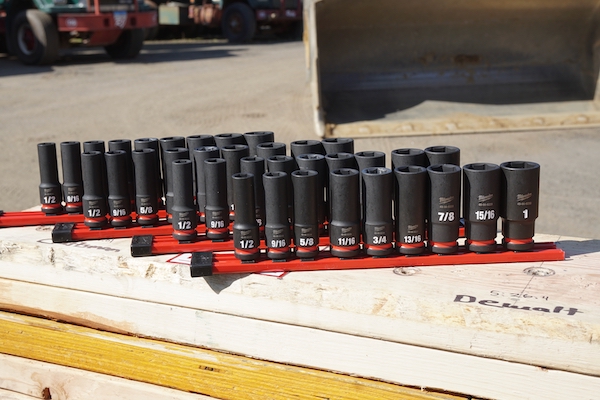















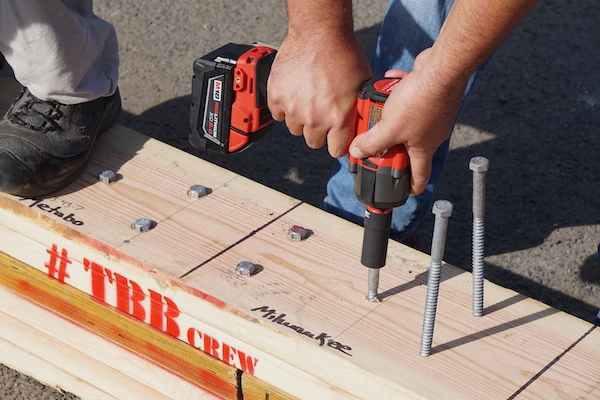

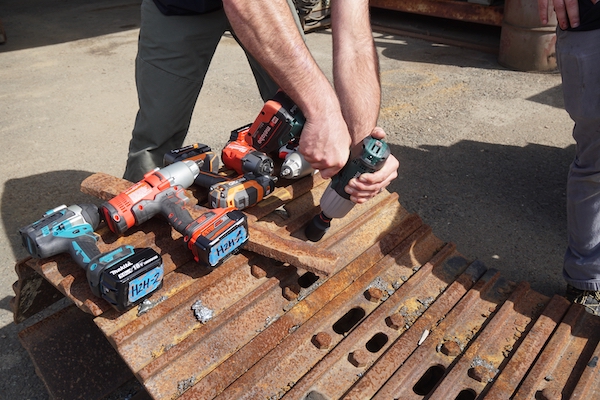








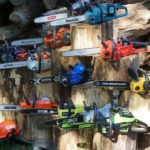

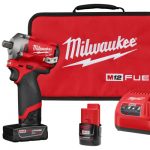












Very interesting article! Any plans on including I/R tools?
Several years ago we did a couple of their tools but they seldom respond to our invitations. We’ll try to get them on board in the future.
Nice article! I bought the Makita XWT11 for automotive work when it came out. That was a mistake, it’s just too weak. hopefully I can sell it and get the XWT18 since I’m invested in the platform. . That Ryobi looks real nice too.
Late to the party, but I find it weird that you tested the lowest powered, and brushed 1/2 inch impact wrench from Craftsman. When they offer a perfectly viable brushless 1/2 wrench that’s way more powerful.
Each company is invited to the test, they are giving the parameters and asked to submit their best match When we did the test this is the model they chose to include.
[…] offering a lower torque rating of 443 ft-lbs and a higher rating of 738 ft-lbs. If you remember our Mid-Torque Cordless Impact Wrench Head-To-Head test, we defined mid-torque as 300-550 ft-lbs of torque. So as you can see this tool really fits both […]
Strange that the 894 did so poorly in your test, when it gets 330 tightening and 600+ loosening in every other tests on YouTube. Had to be something else going on with your version.
I own the 894 as well as the kobalt next generation mid torque and the kobalt spanks my DeWalt. It isn’t even able to break loose what I tighten using the kobalt. Granted,, the kobalt punches well above its specs but my DeWalt just doesn’t compare to my kobalt.